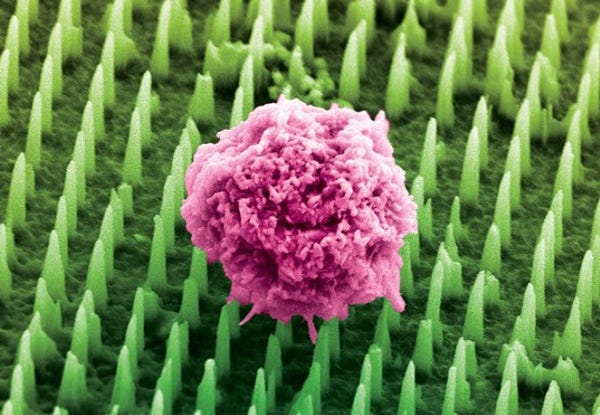New Nanoneedles Could Be an Important Tool to Reprogram Cells
March 31, 2015
Scientists in England have used "nanoneedles" to successfully deliver nucleic acids into the back muscles of mice.
Kristopher Sturgis
|
Image of nanoneedles delivering nucleic acids to a human cell (Courtesy of Imperial College London) |
Researchers from Imperial College London think that a new nanoneedle technique could help deliver nucleic acids to cells. This would then give them the ability to reprogram cells to do many different things, from repairing damaged nerves and organs, to helping transplanted organs thrive in a new system.
Nucleic acids are an essential building block in all living organisms, as they encode, transmit, and express genetic information in living cells. The research team from London has been working in tandem with the Houston Methodist Research Institute to refine a nanoneedle technique that can effectively penetrate and deliver nucleic acids into cells in a safe and effective manner, according to a news release from the university.
The science took a leap when the team was able to demonstrate in a trial the delivery of the nucleic acids DNA and siRNA into human cells in a lab using the nanoneedles. The team found further encouragement when they successfully delivered nucleic acids into the back muscles of mice, resulting in the formation of new healthy blood cells in as little as seven days.
The technique for now has only showed promising results in the generation of new blood vessels. Though, it is worth noting that the mice also exhibited no inflammation or any other harmful side effects during the process.
The group is hopeful that these early results indicate the possibility of one day promoting the generation of new blood vessels in humans, using these nanoneedles as the necessary vessel to carry nucleic acids that can help promote cell function. Researchers believe they could help increase the likelihood of the body accepting transplanted organs. There also might be promise repairing damaged nerves and organs in other areas of the body when needed.
The nanoneedles are tiny porous structures that can act as a sponge imbued with significantly more nucleic acids than traditional solid structures, making them more effective at delivering the payload. They can also bypass the outer membrane of the cell, penetrating and delivering the nucleic acids without harming or killing the cell itself. Each nanoneedle is made from biodegradable silicon, meaning that they can degrade into the body in about two days time, without leaving a toxic residue behind.
Reducing technology to nano-size is becoming a trend in the medtech industry, as researchers continue to shrink technology to increase functionality. From nanolasers utilizing the world's thinnest semiconductor, to biomedical sensors based on silicon nanowires, technologies from every corner are shrinking to microscopic levels in an effort to increase functionality and efficiency.
For now, the London researchers are aiming to develop a material much like a flexible bandage that incorporates nanoneedles. The idea is that this technology could be applied anywhere--on or in the body--to deliver the nucleic acids necessary to reset cell programming and repair the area. The group suspects that harnessing the power of nucleic acids could help them reprogram cells to carry out all kinds of exciting tasks. Repairing scarred tissue, regenerating lost cell and muscle functions, and even promoting the healthy integration of transplanted organs could all be made possible from these tiny microscopic nanoneedles.
Refresh your medical device industry knowledge at BIOMEDevice Boston, May 6-7, 2015. |
Kristopher Sturgis is a contributor to Qmed and MPMN.
Like what you're reading? Subscribe to our daily e-newsletter.
About the Author(s)
You May Also Like


.png?width=300&auto=webp&quality=80&disable=upscale)
